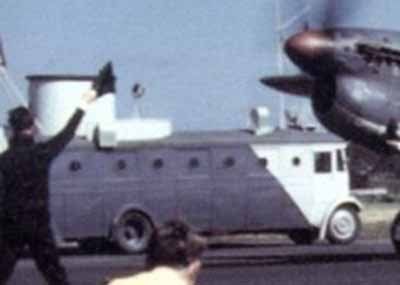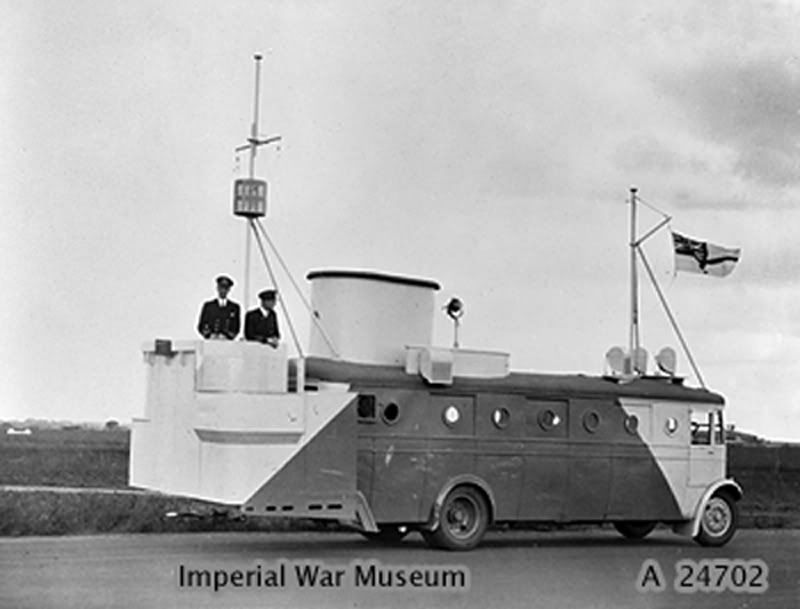
 |
|
#1
|
||||
|
||||
|
This vehicle appears in this picture http://www.ww2incolor.com/gallery/British/barracuda in the company of a Royal Navy Barracuda aircraft.
 It looks like some sort of airfield vehicle perhaps converted from a bus. The paint scheme looks very naval. Can anybody shed any light on this mystery? Fyll |
|
#2
|
||||
|
||||
|
Quote:
It looks like the old bus has been converted in to a "ship", with the windows made to look like port holes and a funnel on the top. Maybe it trundled around the airfield as practise target for the aircraft to home in on? Richard |
|
#3
|
||||
|
||||
|
At first I thought it might be some sort of Runway Control Vehicle, but it doesn't look as if it has a 'glasshouse' which is the trademark of such vehicles.
Fyll |
|
#4
|
|||
|
|||
|
Looks like an AEC bus to me but I could be wrong.I don't think the funnel is part of the vehicle,it appears to be in the background.with the small windows,ariels,vents etc my guess would be a radar vehicle of some kind.
|
|
#5
|
|||
|
|||
|
I'm with Matt, it just feels like an AEC, God knows what it was used for though
Pete |
|
#6
|
||||
|
||||
|
practising carrier landings, the AEC acting as command tower etc?
|
|
#7
|
||||
|
||||
|
Perhaps it's standing in as a U-boat "target" for recognition and aiming - see this pic from the same site:
http://www.ww2incolor.com/gallery/al...type_11_u_boat
__________________
Member: Prairie Command, Ex-Military Land Rover Association 2110, MVPA 29055 ’45 Chevrolet C8A CMP HUP “Staff Car ”, ’82 Land Rover Series III, 109" ex-MoD, ’80 Honda CX500D, ’48 Ferguson TE20 |
|
#8
|
||||
|
||||
|
Interesting ideas!
I think the tower is part of the vehicle, as it appears to be sitting lower at the rear, perhaps as a result of the added weight. I think that the mast just visible in front of the plane's spinner also belongs to the vehicle. Also there must be a significant rear overhang because thee appears to be a mast of some sort on the rear also. A support for it runs from the base of the "funnel" to the left top corner of the photo. Fyll |
|
#9
|
||||
|
||||
|
Given the recent interest in Royal Navy vehicles I thought this might interest some others as well. The answer to this puzzle was supplied by my good friend Mick Bell who located this image
 which is accompanied by this description: THE ROYAL NAVY DURING THE SECOND WORLD WAR Officers on the island of HMS SPURIOUS MARK II a dummy aircraft carrier island at Royal Naval Air Station East Haven at Carnoustie, Scotland. The interior of the single decker bus which forms the basis of the "island" has been fitted with a chart desk, lockers and stowage for chocks. Fyll |
|
#10
|
||||
|
||||
|
Quote:
I was not far out then? I can now see what they did with it, probably set up on a piece of runway suitable marked out to represent a carrier deck, with an arrestor wire, to simulate carrier landings, maybe. Richard |
|
#11
|
|||
|
|||
|
Seems to be a late 30's Albion Bus
Quote:
|
|
#12
|
||||
|
||||
|
Thank you! That's great!
That's one thing I love about this forum. It may have taken 15 years almost to the day, but finally we have an answer! |
|
#13
|
|||
|
|||
|
To this date, the only info "real (?)" that I have on it, point to being a Albion Valkyrie, PW65 chassis (?), maybe with a Cowieson body (the only that could I find with rear opening driver door) as seen on the link bellow.
https://www.flickr.com/photos/iainrobbie9/8507595746/ Being a Albion, two other possibilities are a Valiant or a Victor, but I didn't find a good photo on that direction, some with a dated body, other with a more streamlined one. https://www.gracesguide.co.uk/Albion_Motor_Co:_Buses Many images dont show the "right" side to see the drivers door. Other clues, as the windshield inclination, the wheel rims holes, were found in many buses f the time. I think it is from the 1930-36 timeframe, and locally made, as I have seen other "things" used to the same purpose. https://media.iwm.org.uk/ciim5/30/29...584.1584549594 source: https://www.iwm.org.uk/collections/i...ject/205186688 One point is the absence of the fuel tank gas cap fairing, that is usually on this side, indicating that it is on the other. A problem is that were many body builders, and the transport carriers purchased the bus chassis (with engine, steering, etc) from manufacturers and the bodies were sourced from these builders, and so there were identical ones in different chassis... Cheers! |
|
#14
|
||||
|
||||
|
Thank you Goncalo! Your research is excellent!
You've unearthed a wealth of information! Indeed bus bodies seem to be a worldwide problem for most periods as coachbuilders just fitted their design to different models of chassis. The photo in the IMW link is also fascinating! I did a couple of screen grabs which show the vehicle larger although not very clearly. To me it seems to be a Bedford OY with civilian pattern wheels. |
|
#15
|
|||
|
|||
|
Quote:
I agree with you, a Bedford OY seems do fit!!! Unfortunately, it seems that no more photos of this have surfaced.... It would be a nice contraption to display! |
|
#16
|
|||
|
|||
|
Quote:
I agree with you, a Bedford OY seems do fit!!! |
|
#17
|
|||
|
|||
|
Regarding the Albion bus, some images for illustration purposes.
The bus in this photos is refered as being Albion Valkyrie PW65, bodied in 1931 with a Cowieson B32F body. Unfortunatly this only the chassis and cab survive today... In first photo and second, they shows a external foot stand to the drivers door (despite being higher), as showed on the IWM photo. This can be a chassis feature or a body detail, but it is unique to all the photos that I have looked, as all other similar photos had this feature recessed. They also show the driver door open to the rear, and the point where it toutches the front wheel mudguard also looks very similar.. The number of body panel segments between the wheels seem to be the same too, four, from the drivers door, with the fifth ending over the rear wheel mudguard arch. The bodyword details differ in some points, like the style of the side trims (groved on middle, with a downslope at the rear), the recessed handle on the driver door, or the rear wheel mudguard arches that are more flushed with the bodywork. One other point is the front wheel mudguard arches, both extend to the front and look to be similar, and that bar connecting them at the front, looking closelly, tha IWM photo has also something there too. Again, this is a feature that I only find on photos regarding this model. On the first photo, also no fuel fill recess, that can be just "see/feel" on the third image, between the door and the wheel arch, just where they usually were located. Sources: https://www.flickr.com/photos/92215343@N04/9563444363/ https://www.flickr.com/photos/21611052@N02/47743627611/ https://www.flickr.com/photos/92215343@N04/9563444773/ https://www.flickr.com/photos/george...rs/2680245274/ https://www.flickr.com/photos/63093849@N08/15420176272/ https://www.flickr.com/photos/iainrobbie9/8507595746/ Original IWM image https://www.iwm.org.uk/collections/i...ject/205187213 Some more technical information about the bus chassis: http://archive.commercialmotor.com/a...t-of-the-scott Last edited by Goncalo Mendes; 28-04-20 at 19:20. Reason: images, grammar |
|
#18
|
|||
|
|||
|
Check this:
A color photo: https://www.flickr.com/photos/827078...7605269786717/ A better image of the color photo, and other that I never seen before. https://www.gettyimages.pt/detail/fo...cias/781765809 https://www.gettyimages.pt/detail/fo...ícias/79660619 Last edited by Goncalo Mendes; 02-05-20 at 00:32. |
|
#19
|
|||
|
|||
|
I clicked on the first link in the post above and then started to click forwards through what turned out to be a superb album of colour photos. Mostly of aircraft but also some excellent shots of MVs, including a Bedford MW , Quads with limbers and guns, earlyish CMPs, MP Chevy 3 tonners in the desert. Give yourself plenty of time because this is a big album !
Thank you Goncalo for bringing this to my attention. David |
 |
|
|